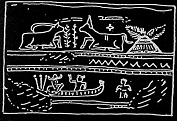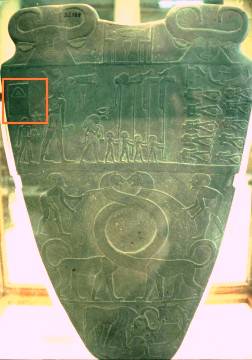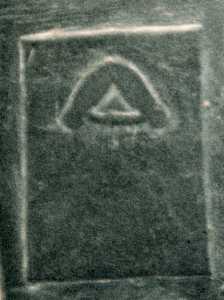

Egyptology separates Egyptian civilisation into "dynasties" which are then placed into groups of three consecutive "kingdoms" separated by "intermediate periods". The larger pyramids of Egypt were built during the Old and Middle Kingdom, while various smaller ones were constructed during the first intermediate period separating theOld and Middle Kingdoms, between approximately 2600 and 1700 BCE. According to standard Egyptology, the famous three great pyramids of Giza were built by the pharaohs Khufu, Kafre and Menkaure during the 4th dynasty in the Old Kingdom, between 2589 BCE and 2503 BCE[1 ]). But this seems to ignore evidence that places the pyramids at a much older date, evidence according to which the pyramids of Giza and the Sphinx were in place even before the first days of Egypt...

|
| Fig. 1 - Pyramid cows? |
Zecharia Sitchin, well known author and so-called orientalist, insisted thad he had found images demonstrating that, 500 years before Khufu, the pyramids of Giza and the great Sphinx were already in existence.[2 ]
However, the pictures did not originate from Egypt but from Mesopotamia, some 100 kilometers away from Egypt, although why people in Mesepotamia should have any interest in drawing pictures of Egyptian pyramids is something known only to Sitchin. What is more, Sitchin does not give any reference indicating the age of the images in question. The Mesopotamian civilisation had an art style which stayed almost unchanged for more than 2000 years, so, without a specific date üictures by themselves would have no value as evidence for a particular era. So the fact Sitchin gives no further details about the imaages displayed in his text makes it impossible to check this particular point, which means that we are obliged to take his claims on trust.
The trust is quickly jolted when we examine the contents of the pictures and compare them with Sitchins claims. The most convincing picture[3 ] is shown on the left. Sitchin claims that the two animals are in fact representations of the Great Sphinx at Giza. And then that the pyramid on the right MUST be the great one at Giza, because "Even details like the inclination - 52 degrees - are matching"[ 4 ].
Hmm... a protractor demonstrates, that the pyramid-shaped object has an inclination of 45 degrees and not, as Sitchin claims, of 52 degrees. And to the best of my recollection the Great Pyramid does not have two large palm leaves protruding from its summit :-)
And what about the Sphinx? Please click on the picture (like all pictures with a frame on these pages it is a link to an enlarged version) and take a look for yourself. Like all sphinxes in Egypt, the statue of the Sphinx has the body of a powerful lion, with its paws out in front, strong hind legs and a lion's tail. The two animals in Sitchin's picture are, however, clearly cows. The position of their fore-legs would be completely impossible if they were lions. When a cow is in a sitting position, its forelegs are generally folded beneath it (as shown in the Mesepotamian image), and do not extend forwards like the forelegs of lions (or the Sphinx).
But what else could the pyramid-shaped object be? Well, it is in fact nothing more than an ordinary reed hut, bound together at the top and crowned with two palm leaves. The whole picture portrays a typical Mesepotamian agricultural scene with grazing cows, fishermen and a hut.

|
| Fig. 2 - Narmer Palette |
Another piece of evidence looks more promising: a pyramid on the so-called Narmer- or unification-palette[5 ]. This palette portrays the moment of the unification of Upper- and Lower Egypt by the hands of the mythical pharaoh Menes. Mythical because nobody knows if Menes ever really existed or not. One good candidate for Menes is Hor Aha, whose birth name is "Mnj", which can be read as "Meni". And, according to the chronicles of Manetho, "Meni" is the name of the first king of Egypt. Unfortunately, however, the primary name on this palette is not Hor Aha, but Hor Nar-Mer, so the question is far from decided.
Although the palette shows the bloody conquest of northern Egypt by the south, there are no indications in the Egyptian historical records referring to such a war. The general opinion is that the unification was a peaceful process lasting several centuries, and that the image on the palette is simply a scene taken from myth. The palette, however, is undeniably some 500 years older than the pyramids. The depiction of a pyramid on this palette would therefore be a powerful piece of evidence for the existence of prehistoric pyramids.
Sitchin tells us that the pyramid can bee seen on the obverse of the palette, although, as is so frequently the case, his book contains only an inadequate drawing of it. The pyramid can be seen right behind the head of the pharaoh, in the red square on Fig. 2. However, after a visit to the Egyptian Museum in Cairo (where I took these photos) I was able to see for myself that Sitchin had edited the picture for his book. Where bulging lines appear on the inner side of the inner triangle, he has straightened them out, likewise, he has also enlarged the inner triangle. But even then, the finished image looks more than a broad letter "A" than it does a pyramid. A letter "A" with soft, bulging outlines. Alternatively, should the inner triangle (which Sitchin straightened up in his drawing) be the pyramid? If so, it would be a very poor representation. And it leaves us with the question: Why was the unknown artist unable to carve a "pyramid" with straight lines? Other parts of the palette demonstrate that he had the ability to carve straight lines when he wanted.

|
| Fig. 3 - Narmer-"Pyramid" |
From the first moment I saw the picture, it seemed to me that this structure must represent something else. Something like a boomerang (yes, the Egyptians had them :-) ) or some other throwing weapon. An exchange of correspondence with a British Egyptologis provided enlightenmentt. The "pyramid" is in fact not a picture at all, but, like other objects on the palette, forms part of an inscription. In these early times the separation between text and pictures was not as clear as it was later to become. In fact, the structure consists of two signs. The surrounding rectangle denotes "land" or "house", and the triangle is a bushel of reed! In the delta region, reed was an important building material,that grew in large plantations. Transporting the reed involved simply throwing it into the water, tied to an A-form structure like the one shown on the palette. If you take a closer look, you even can see the impressions made on the reeds by the rope. So the image on the Narmer-Palette is not a none-too-convincing depiction of a pyramid, but a naturalistic representation of a typical reed float.
The symbol was apparently used later in altered form as the sign "db3" about which the famous Alan Gardiner writes in his book Egyptian Grammar:

The sign was also used when referring to all articles constructed from reed in ancient Egypt: offering shrines, huts, tool sheds...
A simple and intelligible explanation, although not easily accessible to the general reader. But an orientalist like Sitchin should have had no problems in finding it!
| Remarks: | ||
| [1 ] | according to Shaw, Ian; The Oxford History of Ancient Egypt, p. 480 | |
| [2 ] | Sitchin, Zecharia; Die Kriege der Menschen und Götter (German ed. of "The wars of Gods and men", p. 164-172 | |
| [3 ] | ibd. fig. 43, p. 171 | |
| [4 ] | ibd. p. 171 | |
| [5 ] | ibd. Fig. 39, p. 166 | |